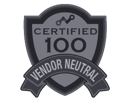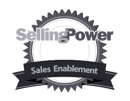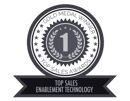
How to design a sales process for complex sales
Despite compelling evidence that companies with a sales process sell more, many don’t have a documented one that is consistently executed by everyone. If you don’t have a sales process, this blog post will get you started.
Still need to be convinced about the effectiveness of adopting a sales process?
According to a recent study underwritten by Sales Performance International (SPI), companies with a documented sales process were more than twice as likely to achieve revenue targets as those that don’t. Without having a staged and milestone-centric sales process as part of your daily operations, you are likely to experience slower on boarding, longer sales cycles and frequent non-decisions.
Without the structure that a sales process provides, even the most experienced sales people will have opportunities fall through the cracks. As for junior sales people, they will be more likely to make rookie mistakes, such as discussing price or presenting the solution before understanding the customer’s circumstances and desired outcome.
So, what is a sales process?
In complex b2b sales, a sales process should outline how a company’s employees help motivate customers to purchase products and services (for the benefit of both). A well-designed sales process allows the replication of best practices and improves sales peoples’ skills while minimizing risks for both buyer and seller.
Stages, milestones and activities
In a broad sense the sales process consists of three components: stages, milestones and key activities. Within this framework, you will need to gather a lot of information and intelligence to understand the customer’s current situation and ambitions for the future.
The 8 Steps of the Sales Process
In complex b2b sales, the sales process stages can look like this:
1. Segment target customers
2. Prospect & pre-qualify
3. Engage and build rapport
4. Understand your buyer
5. Position with value and priority
6. Consensus and commitment
7. Deliver on promises
8. Repeat 3-7
Sales Process Milestones
Once the sales process stages are outlined (like in the example above), it is essential to add milestones that provide an indication that the opportunity is moving forward. It’s helpful to take the buyer’s perspective when setting milestones. What will they need to do in order to make their decision? Examples of such milestones can be: “decision team outlined,” “buying process formulated” and “decision criteria described.” Enter these milestones into the stages you have created.
Side-note: forecasting issues?
A massive problem in most sales organizations is sales forecasting. Historically, each stage of the sales pipeline is given a percentage probability. If the process is designed without thoughtful milestones that ensure progress on the buyer’s side, then the seller who moves the opportunity forward will incorrectly raise the probability and generate incorrect forecast (the pipeline looks big but most deals will never come to fruition).Key Sales Activities
Once you have your stages and the buyer-focused milestones, it’s important to add key activities that help you reach the milestones in the most effective manner. These are the actual activities your sales people will perform, like speaking to the right people at the right time about the right things. Examples of activities can be ”initial exploration call,” ”web meeting with buying team,” ”collaborate business case creation,” ”ROI call with CFO,” ”solution presentation at board meeting,” etc.
Make a list and place the key activities where they should be completed.
Side-note: don’t go crazy
If you describe every single activity, the process will become overwhelming, perceived as micro-management and become difficult for sales people to execute. A sales process is not like a recipe to bake a cake. Provide sales people with enough leeway to feel autonomous and be creative within reasonable boundaries. Nobody wants to be a robot (At least that I know of :).Information to be captured in the sales process
Apart from the stages, milestones and key activities, the process should include steps to capture information that is vital to understand the possibilities in each sales opportunity. The type of information will vary depending on what you sell, however, there is some information that should always s be captured.
Identify the key people involved
In a business-to-business sale, one person rarely makes the decision alone. For instance, an electronics component company selling to a car manufacturer will probably need to involve a purchasing manager, engineers, financial and legal staff. When and how do you know that you have identified all the right people? Who’s the decision maker and what‘s an influencer? Failing to understand the people and politics involved in the buying decision can make the deal go south. This is one reason why the sales process must tell you when and how stakeholders should be identified.
Capture timing to ensure momentum
Time is of absolute essence in sales. If your customer is not moving along and you’re not hitting the required milestones, your sales opportunity is dead. There may be lots of activity, but no progress – a big red warning flag! Too often, sales people move opportunities along in the sales process while the buyer is on another wavelength. The milestones in the sales process need to map the buying journey and you always need to have an agreed upon next step. Make sure that your sales process includes appropriate timing between milestones and activities. Whatever you do, don’t lose momentum in your deals, or rest assured, you’ll have poor sales results – no matter how fine your sales process looks on paper.
Understanding the past, current and future
Many years ago, when attending a public speaking training session, the teacher said: “In the absence of a script, just use past-present-future. By starting with a story of the past, follow through to the present and round off with a future vision. Can’t go wrong.” This technique works well to figure out the motivation of your buyer as well. Make sure that your process guides sales people through questioning that capture the buyer’s perception of the past, present and future as well as the context and priority of the problem and desired outcome.
Know your competition
There is no such thing as “no competition” and the biggest contender is the status quo. The problem you want to help solve may have been around for years. Work-arounds have served well enough not to do anything. Why should prospects change now? If they’ve made up their mind to change and have outlined their ambitions, who helped form their view of the best solution? Was it you? If not, it was probably your competitor… Include steps to capture the competitive landscape and know your strengths and weaknesses against your competitors.
How many do it right?
Data from the Objective Management Group shows that about 10% of nearly 1 million assessed sales professionals actually work for a company where a best-practice sales process is executed in daily operations. This is discouraging and needs to be fixed. I would argue that most companies can increase their revenues by 20-30% just by introducing sales process combined with a simple methodology (unsure about the difference? read this article) and basic sales coaching.
Learn from wins and losses to improve the process
Always strive to improve your sales process. Learn from what is working and isn’t working. Set aside time to analyze your wins and losses and use the knowledge to encapsulate new success factors into the process. Only through learning better execution will you have an advantage on your competition. Use your sales process and methodology to get ahead, grow with every sale!
From theory to practice
Once you have defined and mapped your sales process, you need to put it to work. This is where you need Membrain. It was designed to accommodate any sales process and visually guide sales people through the process in an easy to use web interface. Membrain highlights prospects and deals that need attention so that coaching or guidance can be provided to move them along or close them. Membrain is unique in that it focuses a sales team on making progress rather than logging activities. Companies gain an advantage with Membrain because it helps them master the complex sale.
I’ll close with this thought from Edward Deming, Quality Management Guru: ”If you can’t describe what you’re doing as a process, you don’t know what you’re doing.”

By George Brontén
George is the founder & CEO of Membrain, the Sales Enablement CRM that makes it easy to execute your sales strategy. A life-long entrepreneur with 20 years of experience in the software space and a passion for sales and marketing. With the life motto "Don't settle for mainstream", he is always looking for new ways to achieve improved business results using innovative software, skills, and processes. George is also the author of the book Stop Killing Deals and the host of the Stop Killing Deals webinar and podcast series.
Find out more about George Brontén on LinkedIn









